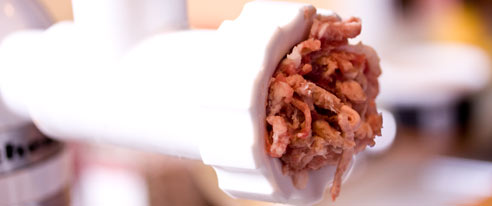Differences Between Paté - Terrine, Galantine - Ballotine; & Mousse - Mousseline
Differences Between: Paté - TerrineGalantine - BallotineMousse - Mousseline
Paté - Terrine
|
Sr. No. |
Paté |
Terrine |
|
1 |
Paté
is lined with pastry casings |
Terrines
are lined with pork fat |
|
2 |
Derived
from French word which means ‘paste’ |
Derived
from Latin word ‘terra’ meaning earth. |
|
3 |
Forcemeat
used in Pate is finely chopped or pureed |
In
this the forcemeat is slightly coarse |
|
4 |
In
this liver is used as main ingredient E.g.
Paté de foie gras |
Various
forcemeat can be used and layered one over the other |
|
5 |
Baked
in rectangular mould |
Cooked
in double boiled in an oval earthenware dish |
|
6 |
Sliced
and served |
Served
sliced or are scooped with spoons |
|
7 |
Demoulded |
Not
demoulded |
|
8 |
For
extra fragrance, a small qty of wine or brandy can be added |
Fragrance
is attained by using fresh herbs like bayleaf, rosemary |
|
9 |
Fat
is incorporated inside it |
Fat
is absorbed while cooking because of bacon lining |
|
10 |
Generally
cooked forcemeat is used in it |
Uncooked
forcemeat is used in it |
|
11 |
Baked
at a temp. of 400-425oF for 15 min. Allowed to cool for 15 min and
final cooking is done at 350oF till internal temp reaches 170oF |
Terrines
are cooked in double boiler at a temp of 325oF and the temp of
water should be 190oF. When the internal temp reaches 140oF,
it is done |
|
Sr.No. |
Galantine |
Ballotine |
|
1 |
It is
only cooked by poaching method |
It
can be poached, baked or braised |
|
2 |
Entire
skin of poultry is used |
Leg
of poultry |
|
3 |
Served
only cold |
Can
be served hot or cold |
Mousse - Mousseline
|
Sr. No. |
Mousse |
Mousseline |
|
1 |
Served
cold |
Served
hot or cold Hot –
Accompaniment to various main courses |
|
2 |
Cooked
meat |
Uncooked
fish meat |
|
3 |
Binding
done by aspic / veloute and cream |
Binding
done by egg white and cream |
|
4 |
Set
in refrigerator |
Set
using double boiler |
|
5 |
E.g.
Chicken mousse, tricolour mousse |
E.g.
Eel mousseline |





👌👌
ReplyDeleteVery nice explained 👍
ReplyDeleteVarchasva bhardwaj
Thank you so much sir😊
ReplyDeleteInformative content sir.
ReplyDeleteThank you .
nice sir!
ReplyDeleteThankyou for the notes
ReplyDeleteVery nicely explained..
ReplyDeleteVery informative
ReplyDeleteThankyou sir
Nicely explained 💯
ReplyDeleteThank you for the notes sir
ReplyDeleteTanvi
Thank you for the notes sir
ReplyDeleteMarvelous
ReplyDeleteThanks for the information
ReplyDeleteThis side nikunj
DeleteThanks for the information
ReplyDeleteThank you sir
ReplyDeleteThankyou sir
ReplyDeleteThank you sir.
ReplyDeleteThank you sir
ReplyDeleteThnku so much sir
ReplyDeleteThanku so much sir
ReplyDeleteThankyou sir
ReplyDeleteThank you sir for clearing our doubts on these topics
ReplyDeleteVery informative notes thank you sir
ReplyDeleteNice notes sir
ReplyDeleteVery well explained content
ReplyDeleteGreat
ReplyDeleteNice Content Sir!!
ReplyDeleteinformative notes
ReplyDeleteThanks for such informative notes sir..
ReplyDeleteThank you so much for the notes sir.
ReplyDeleteThanku sir..
ReplyDeleteRegards Yash Bhardwaj
Thanks sir
ReplyDeleteThank u sir
ReplyDeleteThank you for notes sir
ReplyDeleteNice sir
ReplyDeleteGood information sir
ReplyDeleteDiscuss the function of water in our body? What are the visible & invisible sources of water?
ReplyDeleteAns.) An important nutrient .75 to 80 percent of our total body is water. it’s a structural & functional unit of our body. the whole humour is distributed among two major components.
Extracellular fluid – contain sodium
Intercellular fluid – contain potassium & these two ions have to be maintained all time.
Water is formed from hydrogen & oxygen the ratio is 2:1. We lose water daily through sweat, urine, feces, etc. The deficiency of water causes dehydration, so we’ve to take care of the water balance of our body.
https://www.ehospitalitystudy.in
https://www.ehospitalitystudy.in/nutrition-faq/
Thanks, great explanation, well set out for easy reference.
ReplyDelete